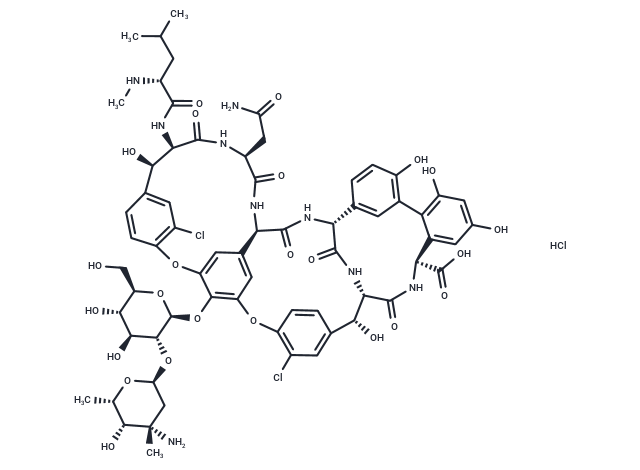Shopping Cart
Remove All Your shopping cart is currently empty
Your shopping cart is currently empty
Vancomycin hydrochloride (Vancomycin HCl) is a glycopeptide antibiotic that targets Peptidoglycan in bacterial cell wall synthesis. Vancomycin hydrochloride is mainly used for the treatment of severe Gram-positive bacterial infections.

| Pack Size | Price | USA Warehouse | Global Warehouse | Quantity |
|---|---|---|---|---|
| 500 mg | $39 | In Stock | In Stock | |
| 1 g | $54 | In Stock | In Stock | |
| 2 g | $76 | - | In Stock | |
| 5 g | $123 | - | In Stock | |
| 10 g | $179 | In Stock | - | |
| 1 mL x 10 mM (in DMSO) | $39 | In Stock | In Stock |
| Description | Vancomycin hydrochloride (Vancomycin HCl) is a glycopeptide antibiotic that targets Peptidoglycan in bacterial cell wall synthesis. Vancomycin hydrochloride is mainly used for the treatment of severe Gram-positive bacterial infections. |
| Targets&IC50 | HEK293 cells:> 100 μM (CC50), L02 cells:> 30 μM, L1210 cells:> 1000 μg/mL |
| In vitro | METHODS: Methicillin-sensitive Staphylococcus aureus, methicillin-resistant Staphylococcus aureus, Staphylococcus epidermidis, Streptococcus agalactiae, Streptococcus bovis, Streptococcus mutans, Streptococcus aureus and Enterococcus were treated with Vancomycin, and the minimum inhibitory concentration was detected by MIC assay. RESULTS: Vancomycin inhibits the growth of various Gram-positive bacteria, and the MIC of Vancomycin against methicillin-sensitive Staphylococcus aureus is 0.25-10 μg/mL. [1] |
| In vivo | METHODS: To study the in vivo pharmacokinetics of Vancomycin, cyclophosphamide was intraperitoneally injected into female ICR mice to induce neutropenia. Six vancomycin products (100 mg/kg; A single dose was subcutaneously injected into mice. Blood samples were collected at 0.25, 1, 2 and 4 hours after administration to determine the serum concentration of vancomycin. RESULTS: The Cmax of the original research product Vancocin CP was 86.92 mg/L, and the AUC was 135.93 mg·h/L. The Cmax and AUC of the five generic drugs were all lower than those of the original research products, and the 90% confidence interval did not fall within the range of 80% - 125%. The half-life (T1/2) was between 0.56 and 0.83 hours, and there was no significant difference among the products. [2] METHODS: To study the in vivo pharmacodynamics of Vancomycin, Vancomycin (25, 50, 100, 200, 400 mg/kg) was subcutaneously injected into mice with neutropenia and Staphylococcus aureus inoculation in the femoral region. This was repeated every 6 hours for a total of 3 times. Twenty-four hours later, the mice were sacrificed, and the femoral tissue was homogenized. After dilution, the bacteria were counted on the plate. RESULTS: The ED50 and 1LKD of the original research product and the generic drug are similar. However, in mice inoculated with low doses of ATCC 29213 and Mu3, the BD of generic drugs B, C and E showed significant differences from the original research products. [2] METHODS: To study the in vivo toxicity of Vancomycin, Vancomycin (300 and 400 mg/kg) was administered to Sprague-Dawley rats three or four times a day for 24 hours. The concentration of vancomycin in plasma was determined by LC-MS/MS, and the biomarkers of renal injury in urine were analyzed. RESULTS: A high dose (400 mg/kg) of vancomycin showed significant nephrotoxicity in rats, manifested as a significantly elevated level of KIM-1. At a dose of 300 mg/kg, the nephrotoxicity was relatively low, but renal function impairment still occurred in some rats. [3] |
| Synonyms | Vancomycin HCl |
| Molecular Weight | 1485.71 |
| Formula | C66H76Cl3N9O24 |
| Cas No. | 1404-93-9 |
| Smiles | C[C@H]1[C@H]([C@@](C[C@@H](O1)O[C@@H]2[C@H]([C@@H]([C@H](O[C@H]2OC3=C4C=C5C=C3OC6=C(C=C(C=C6)[C@H]([C@H](C(=O)N[C@H](C(=O)N[C@H]5C(=O)N[C@@H]7C8=CC(=C(C=C8)O)C9=C(C=C(C=C9[C@H](NC(=O)[C@H]([C@@H](C1=CC(=C(O4)C=C1)Cl)O)NC7=O)C(=O)O)O)O)CC(=O)N)NC(=O)[C@@H](CC(C)C)NC)O)Cl)CO)O)O)(C)N)O.Cl |
| Relative Density. | 1.657 g/cm3 |
| Color | White |
| Appearance | Solid |
| Storage | keep away from moisture | Powder: -20°C for 3 years | In solvent: -80°C for 1 year | Shipping with blue ice/Shipping at ambient temperature. | |||||||||||||||||||||||||||||||||||
| Solubility Information | H2O: 33.33 mg/mL (22.43 mM), Sonication is recommended. DMSO: 85 mg/mL (57.21 mM), Sonication and heating are recommended. | |||||||||||||||||||||||||||||||||||
| In Vivo Formulation | 10% DMSO+40% PEG300+5% Tween 80+45% Saline: 3.3 mg/mL (2.22 mM), Sonication is recommended. Please add the solvents sequentially, clarifying the solution as much as possible before adding the next one. Dissolve by heating and/or sonication if necessary. Working solution is recommended to be prepared and used immediately. The formulation provided above is for reference purposes only. In vivo formulations may vary and should be modified based on specific experimental conditions. | |||||||||||||||||||||||||||||||||||
Solution Preparation Table | ||||||||||||||||||||||||||||||||||||
H2O/DMSO
DMSO
| ||||||||||||||||||||||||||||||||||||
| Size | Quantity | Unit Price | Amount | Operation |
|---|

Copyright © 2015-2026 TargetMol Chemicals Inc. All Rights Reserved.